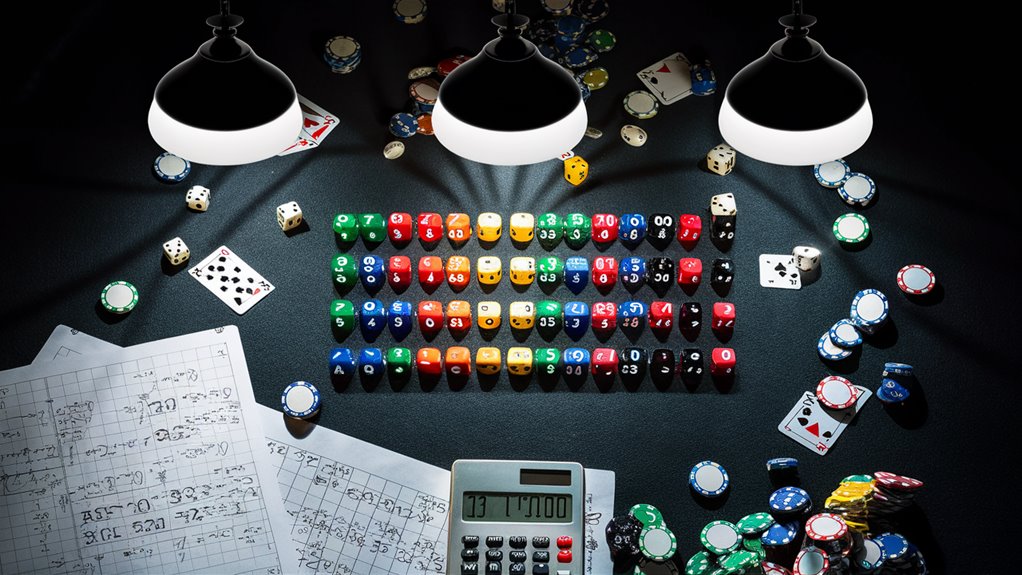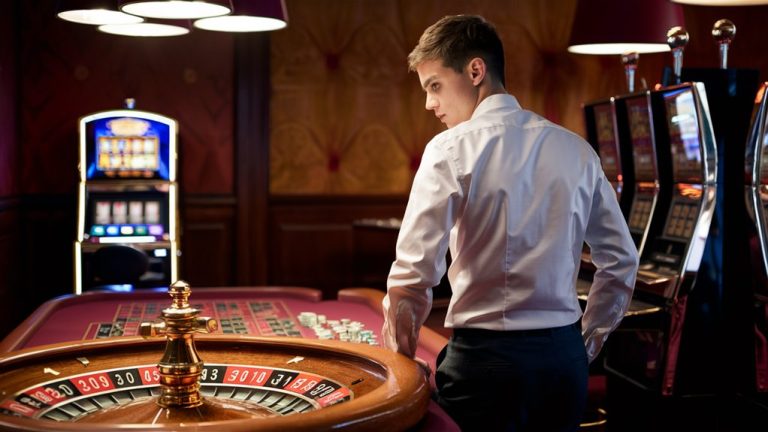
Mathematics Behind the Games at the Casino
Probability and statistics are the fundamental backbone of all casino games. They determine such crucial factors such as house edge and expected value (EV). These mathematical principles govern every step or spin in our world.
Basic Mathematical Concepts
European roulette provides an example of precision probability calculation. The house edge is 2.7% (a figure derived from the 1/37 chance on every single number bet). In comparison, blackjack is built on rather more sophisticated arithmetic and offers an astonishingly low 0.5% house advantage when players use optimal strategy.
Modern Gaming Technology
Pseudo-random number generators (PRNGs) power the digital casino games that we play today. These algorithms enable fair and unpredictable outcomes as they embody advanced mathematical principles throughout their operation. This is how PRNGs mimic true randomness in a virtual setting.
Advanced Game Theory
Maths + psychology underpin strategic games such as poker. Here, mathematical concepts like Nash equilibrium and ranges that are balanced explain how you can tilt the odds in a game to your advantage through Poker. Those principles help players to think along the lines of probability distribution. Then one day, if they are lucky enough, collision with Reinforcement lea results in success as an event that fulfills many stochastically favorable expectations.
Without understanding the basic foundations of this mathematical framework, it is difficult to imagine how casinos maintain their advantage while offering a fair gambling experience.
Probability Theory in Casino Games
It is so frustrating to visit many of the sites in the online-gambling market with a promise of endless game knowledge and resources, only to find that their writers know nothing about gaming or mathematics! It is quite clear from a casual browse through Gambling.net how fundamental this concept is nowadays. It cannot be overemphasized too much just why mathematicians are attracted Why Casinos Use Psychological Tricks to Keep You Playing to playing should really some tips on games more akin consequently.
How Casinos Make Use Of Mathematics
Probability theory informs the basic processes of all gaming, spilling its numbers out over every known scenario in gambling.
In card game probabilities, there are numbers of combinations to be used in this calculation that are very difficult. The total possible five-card poker combinations follow the formula C(52,5) 52x51x50x49x48/5x4x3x2x1 = 2,598,960 hands. Notable probabilities include:
Royal Flush: 4/2,598,960 (0.000154%)
Straight Flush: 36/2,598,960 (0.00139%)
Four of a Kind: 624/2,598,960 (0.0240%)
Blackjack Strategy
Blackjack probability calculations change a player’s odds as the game goes on, when cards are taken from play.
Probability shifts accumulating over successive games unemployment in a card counting system impact best betting and playing decisions based on hole card counts and the number of decks remaining to be dealt.
As long one not lured onto nonsensical paths such as betting groups that cannot be depleted or expecting production during a time frame when our experience suggests production is impossible at any price, this helps eradicate those all too common wrong way errors. “This mathematical framework powers casino game design, establishing verifiable odds and expected returns across all gaming scenarios.”
The House Edge Explained
Understanding the House Edge in Casino Games
How Casino Mathematics Works
The house edge represents the mathematical advantage inbuilt into casino games that will eventually ensure long-term profits for the gaming establishment.
This statistical edge means that luck with consistent regularities rather than with the flawless balance to which science should extend; the aim of gaming art is therefore a just equilibrium between mathematical skill and its emotional flourishes.
Roulette’s Built-in Advantage
European and American roulette demonstrate the house edge principle perfectly. The presence of green zero spaces (0 in European, 0 and 00 in American) creates an imbalance in what appears to be even-money bets:
European Roulette: 2.7% house edge (1 zero)
American Roulette: 5.26% house edge (2 zeros)
True odds: 18/38 (47.37%) on red/black bets Payout odds: 1:1 despite reduced probability.

Blackjack’s Strategic Edge
The blackjack edge arises from multiple mathematical sources:
Sequential play: 0.5-1.5% base house edge
Player goes first action: Forcing player decisions before dealer
Bust rules: Player loses straight away regardless of what is eventually declared by the dealer
Standard payouts: 1:1 for regular wins
Natural blackjack: 3:2 top win odds
These are carefully constructed mathematical components which when executed with large enough samples together attain a reasonable margin to hold over time in the winner’s hands.
Random Number Generators
Understanding Casino Random Number Generators (RNGs)
How Casino RNGs Power Modern Gaming
Random number generators (RNGs) play the role of the electronic casino when delivering unpredictable outcomes, a primary reason why they need unpredictable input themselves. How to Play Poker Like a Pro – Advanced Strategies
These elaborate systems of technology are made up and to trick you will get even more elegantly attired and choice slot machines.
Data Oriented Model of Casino RNGs
The heart of casino gaming operates around what are called pseudo-random number generators (also called PRNGs). These PRNGs use a clever idea to produce sequences of numbers. By using complex mathematical formulas, thousands of different sequences are created in just one millisecond. You can think of it as getting a pot of water boiling and then letting steam rise up until whole clouds expand outwards.” Seed values for initial number generation
Modular arithmetic calculations
Prime number algorithms
Continuous Generation Schemes
RNG Implementation in Casino Games
Electronic gaming systems use continuous RNG processes. Having a frequency of thousands of results per second.
When a player interacts with games, the system captures an instant in this constantly ongoing process of generating numbers and turns it into gaming results.
Regulatory Compliance and Testing
Gaming authorities have comprehensive testing protocols for casino RNGs. These include procedures like:
Chi-square statistical analysis
Distribution pattern checks
Probability alignment inspections 먹튀사이트
Regular system checks
These strict testing processes make sure that number generation keeps true randomness. And they therefore meet the requirements for the strict regulatory standards of fair gaming.
Expected Value and Variance in Gambling: A Restaurant to Help You at Every Stage of the Road of Financial Aid
The Fundamental Principles of Expected Value
The Expected Value (EV) of an investment is a fundamental idea in mathematical gambling. It is a critical number that represents how much we expect to make on average from one round (or other number of rounds) into the future. To work out how much such a scenario is worth: multiply. The expected value of a professional gambler is a positive one (+ EV indicates long run profitability) while under poor circumstances one that does not tell their fortunes well.
Variance Study in Gambling
By measuring the variance, you quantify the size of fluctuations that might occur in any given gambling situation. To calculate variance, we calculate squared differences between all of the potential outcomes and get a mean (weighted by probabilities). The standard deviation is the square root of variance. It can provide key insights into the range of possible outcomes and degree variances may be expected.
Strategic Application Gambling Decision Making
To achieve a successful gambling strategy, you need to balance both the expected value and variance indicators. Once you reach a certain level of variance, even though the expected value remains upwards from zero, you must be an ace at bankroll management to stay in there for long. Tournament poker, in sum, embodies this very idea that mathematically profitable positions are necessarily volatile and require strong bankroll management to sustain in the long run.
The key components: Expected Value Calculation: Outcome × Probability)
From a practical perspective, what this means for risk management is to balance expected value against variance exposure: in other words, let go of high-risk/reward opportunities and be more conservative when it’s lower. Variance Assessment: (Outcome – EV)² × Probability)
The size of your bankroll should be adjusted to your current variance level. Balance Risk and Expected Value.
Game Theory and Poker
Advanced Game Theory in Poker
Nash Equilibrium: a Primer for Understanding Poker
By offering a mathematical framework for dealing with these difficult decision-making problems, game theory changes totally the strategic landscape of poker. Nash equilibrium holds when every player’s tactic is optimally adjusted against those of all the others. The basis for this more advanced sort of poker is mixed strategies made up of probable actions that are spread out over time and space.
Winning Management and Bettor Behavior
Game Theory Optimal (GTO): A Paradigm Shift in Poker Strategy
By using a GTO strategy, each player’s betting frequencies and selection of bet sizes are completely changed. Thus, as you face a river bet, you have to work out your call rates on some precise mathematical basis. No guesswork here. The minimum defense frequency (MDF = pot size / (pot size + bet size)) is the fraction of the time needed to use each of these optimal ranges in order for calls to be neutralized against betting opportunities from an opponent.
Balanced Range Development
Range development represents a critical application of game theory in poker. Players must construct balanced ranges that include both value hands and bluffs, which will appear in certain ratios. The ratio of bluffs to value bets should correspond to the pot odds, and this alignment signifies a betting pattern that makes sense from a mathematical standpoint. These strategies are not exploitable. By making all expected value maxima against each of those opponent adjustments, we ensure that any changes made by our adversaries will not hurt us—whatever they might come up with, it doesn’t matter in fact. This approach creates bulletproof structures for gaming down at your own level or higher while also bringing to light new threats that come along with sophistication.




